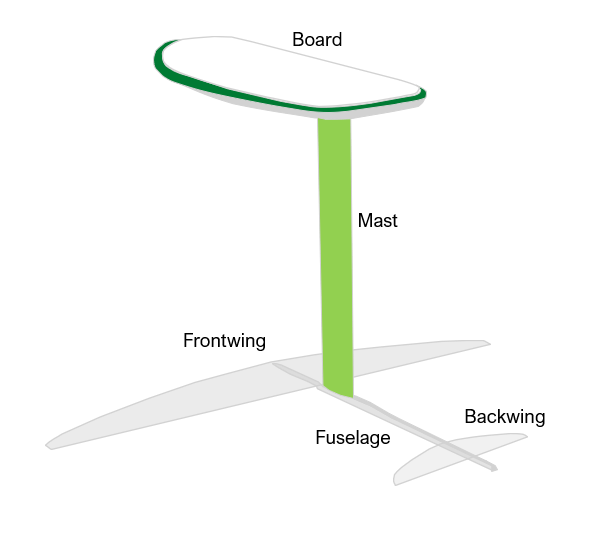Basic setup of foiling gear
To start with foiling, you basically need a board with a foil. There are different boards, and foils on the market. Dependent on what you like to do (pumpfoiling, wavefoiling, kitefoiling …) you will need different foils and boards. Therefore, when deciding to go for your own equipment, make sure you know what your your intentions are.
However, independent if you go for wake-, wave- or pumpfoiling, the equipment will exist of the follwing main components:

Frontwing
The frontwing generates the lift required to make you “fly”. There are different designs and as mentioned, they must match your intended use. When you start to look into different foils, you will be confronted with many different dimensions and descriptions of foils. An overview about the meaning of those dimensions can be found here Dimensions of a foil and their meaning.
In general we can state that the bigger a foil the bigger is its lift, means also the more lift it generates at lower speeds. However, that is really a very general statement.
Nevertheless, you will observe that for foiling sports at higher speeds, people use bigger foils as they – as just stated – produce more lift.
Backwing
The backwing is mounted at the rear end of the fuselage and has several functions: It provides stability and therefore is also often called “Stabilizer”, provides control, counteracts the lift of the front wing and also damps the pitching moment of the foil.
As a general statement we can say that the bigger the backwing the more stability we gain.
Mast
The mast connects the fuselage with the board. There are different lengths of masts available and many brands also offer masts of different material. Most common materials are aluminium and carbon.
The length of the mast is dependent on what you want to use your foil for. Having a longer mast increases the distance between the foil and the board which will be an advantage in wavy conditions to gain more “room” between the surface of the water and the board. However, longer is not always better. There is a video which pretty well explains the pros and cons of short or long mast at the example of pumpfoiling. However, the reasons mentioned in the video can also be applied for the other foiling sports.
Fuselage
The fuselage connects the mast with the front- and backwing. You will find different models of fuselages which different in their length and material.
Same as for the shapes and sizes of the front- and backwing, we could spend here quite some time in detailled explanation about the impact of the length of the fuselage in combination with the wings attached to it. And it is also important to look at the combination. However, if we want to do a general statement we can say that “the shorter the fuselage the less stable and more agile” is the foiling setup.
Board
Last we want to have a quick look at the board. The board is the “plattform” for the foiler. That is also the main function. However, we have to be aware that there is a “take-off” phase for all the foiling sports. Is it the dockstart when pumfpoiling, paddling the wave when surffoiling or accellerating and lifting out of the water when wingfoiling.
For pumpfoiling, you really ‘just need a platform to put your feet’. Well as with everyting, there is also here a ‘but…’. Just having enough space for the feet may not enough. When doing the pumping movement, you also have to induce a moment bring the board down. There is a video which describes that in greater detail: Pumpfoiling Importance of the Body Position and Weight Distribution.
So besides the function of having a plattform for the body, the board transfers the force onto the foil. Additionally, having some buoyancy of the board helps when paddling back to the shore in case you fell of the board.
For surffoiling you need in general a board that has at least some buoyancy to allow you to gain some speed while paddling into the wave to catch it. In case the board is fully submerged when paddling on it, it will be very hard to manage the take off.
Similar is the situation for wingfoiling. Also there you have an initial phase where the board is with no speed in the water. So in case you cannot overcom the drag to move the board out of the water, you will have no chance to get into the foiling. For beginners, you generally state that the board should have a volume of at least 20% more than the body weight, means for a person of 80 kg e.g. at least 100 liter board volume. For sure, the more experienced you are the smaller you can go with the board.